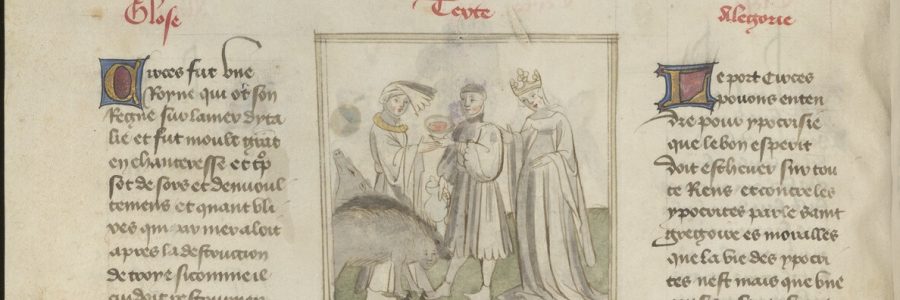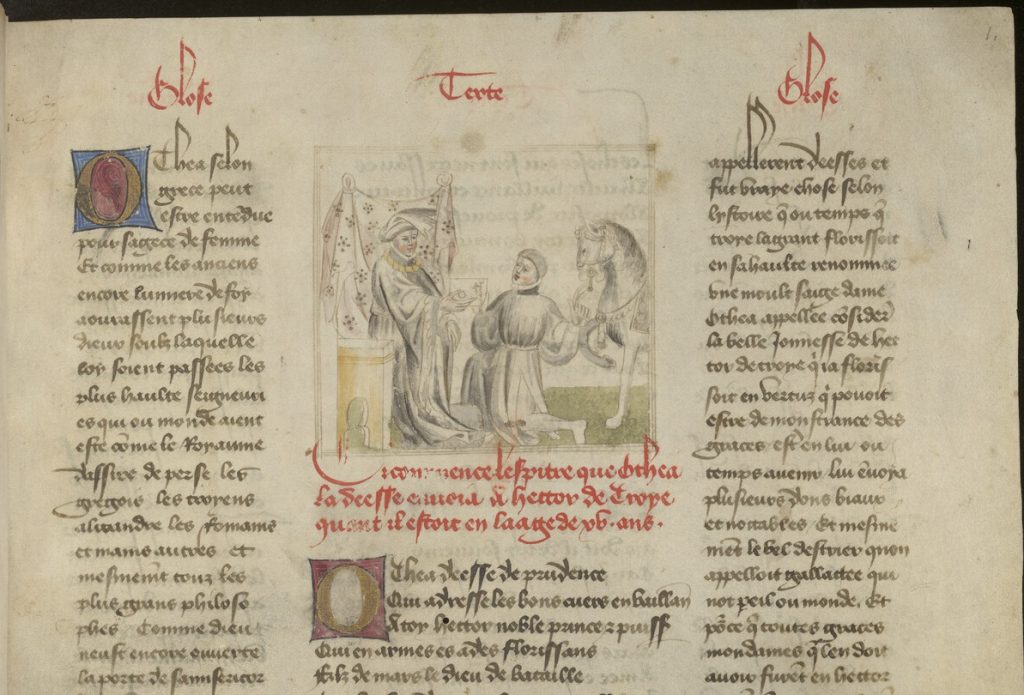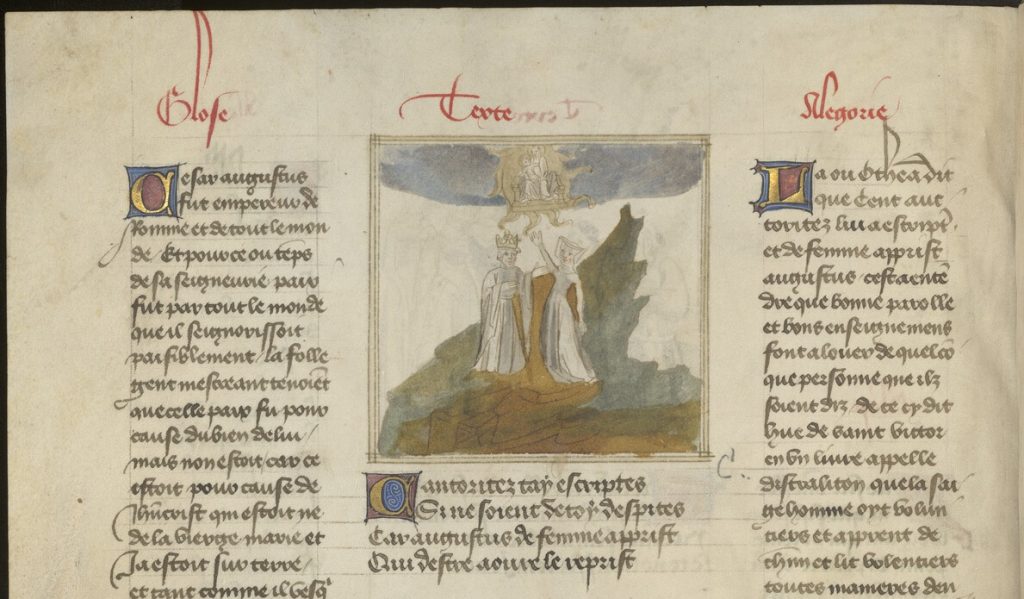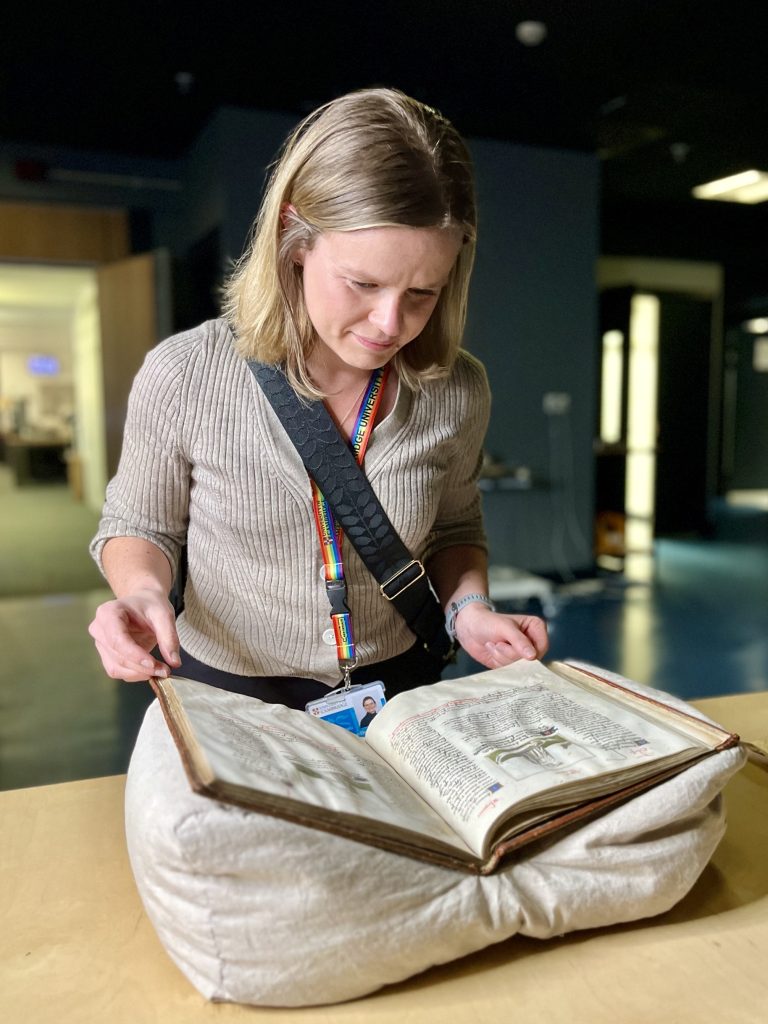
Newnham College Christine de Pizan manuscript digitised
This post is by Dr Charlotte Cooper-Davis, Learning and Research Engagement Officer at the University Library. She has been researching and writing about the fifteenth-century writer Christine de Pizan since 2009: her doctoral thesis (2016) focused on the visual aspects of Christine’s rich corpus of illuminated manuscripts and she has since written two books and several articles on Christine and on medieval literature more generally. This post tells the story of Charlotte’s engagement with a fifteenth-century Christine manuscript at Newnham College, recently digitised on the Cambridge University Digital Library.
No matter how much time a researcher might get to enjoy looking at medieval manuscripts online, nothing compares to the experience of seeing one in real life. This is partly a sensory experience: the particular musty animal smell of parchment that is many centuries old, the weight of the pages as each leaf is picked up, hearing them crackle as they are gently turned… But what I find most exciting about seeing a medieval manuscript is being able to experience a text like a medieval reader would have done. A shared encounter across the centuries.
And so it is that I came to be running through the corridors of the University Library: I had just received word that Newnham College MS 5 – a copy of Christine de Pizan’s Epistre Othea – had arrived in the Cultural Heritage Imaging Lab, where it was shortly to be photographed for digitisation. I was eager to see it again. The photography team were somewhat bewildered: it seemed none of them were as excited as I was about this manuscript’s being in the building.
When I arrived in the Imaging Lab, the wave of anticipation had still not hit my colleagues. ‘Er, it’s probably here somewhere, could it be in the safe?’ suggested Blazej, one of the photographers. ‘What sort of thing are we looking for?’ I described the manuscript as best as I could remember: a bit more than A4 in size, an inch or so thick – it’s only around 100 folios. We eventually found it in the safe, safely encased in its conservation box. Once it had been gently removed and placed on a cushion, I once again delighted in turning its crispy painted pages.
The last time I had seen this manuscript was a rather different experience. It must have been the second year of my DPhil that I came to Cambridge to look at two copies of the Othea in preparation for an article I was writing on the text (the other being St John’s College, MS H.5). The trip had taken several months of planning. When I eventually made the journey to Cambridge, a designated desk had been set aside for me directly in front of the librarian at Newnham College Library from where I was able to spend a little time in its company, always right under her watchful eye.
On that visit, I was allowed to take three photographs of the manuscript. But which three? At the core of my argument were ten chapters, each taking up the recto or verso of one folio, so 20 pages in total. It would not be possible to take capture all of this material on camera so good notes and memory would be essential. In the end, I opted for the opening of the manuscript, which controversially (though not uncommonly) shows a man presenting his manuscript in place of the female author (above), an image of a chapter I knew that I would use in my argument, and the final page of the manuscript which depicts an image of the Virgin and Child being used as an exemplar for Emperor Augustus (below). All three images shared an iconographic programme with the author-manuscripts of the same work that I was keen to explore further, but going forward I would be reliant on this small sample of images and my descriptions.
It is ironic that my work on this manuscript fed into a wider project whose core argument was that the images in a medieval work should be read just as much as the text – the final image itself makes it clear how much medieval audiences relied on iconographic representations to educate their readers – yet unless they are digitised, those images are practically inaccessible. Viewing a manuscript for research purposes in such circumstances is therefore a strained and pressurised task: there’s an urgency to the data-collection which doesn’t sit well with the delicate task at hand, a need to ensure all information that might be needed for the current project (not allowing ourselves to think of any future projects…) has been accurately recorded – because once the manuscript has been taken away, it won’t easily be possible to view it again.
This will no longer be the case for scholars wishing to work on this manuscript, on which research is surprisingly scant. One of the most tantalizing questions about the Newnham copy of the Othea is whether or not Christine de Pizan herself was involved in its preparation, a question posed by Sandra Hindman back in 1986, on which the authors of the 2012 Album Christine de Pizan are surprisingly silent. The authors of this 800-page volume, an analysis of Christine de Pizan’s 56 author-manuscripts, do not mention this copy of the text. Yet the Newnham manuscript is believed to have been prepared in Paris in the early to mid-fifteenth-century, precisely the time and place that Christine’s scriptorium was active. Its hands merit further analysis and comparison with the author’s three known scribes, as it is not impossible that it was prepared under her supervision. If so, we might also ask when the illuminations were added – their style is unlike any of the other author-copies of the Othea, so my own view is that these are unlikely to be contemporary with the text.
There is nothing like getting to spend a little time with a medieval manuscript, but nor is there any denying the opportunities that digitisation opens up. Not only are images open and accessible to anyone with access to a computer and an internet connection, with none of the barriers created by travel, transport, and accommodation, or the need to make arrangements months in advance, but the level of zoom is such that the detail that can be seen is better than with the naked eye. Thanks to IIIF technology, researchers will even be able to view this manuscript alongside other copies of the Othea (or other medieval manuscripts) – even those located in different repositories, countries, or even continents. This might help us to answer some of the outstanding questions surrounding the manuscript with a little more certainty, chief among them: could it be possible that this manuscript is another of Christine de Pizan’s author-manuscripts?



